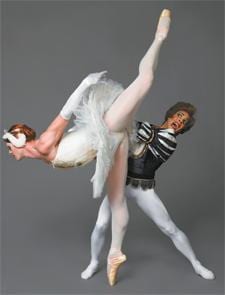Joshua Grant, a gay member of Les Ballets Trockadero de Monte Carlo — who performs as Katerina Bychkova when he dances the girls’ parts — wants to make one thing perfectly clear: this is not a drag show.
“It has a lot of humour, it has a lot of style, and it has men dancing girls’ parts,” says Grant while visiting family in Arizona during a break, “but we’re serious dancers, technically proficient dancers. Trockadero isn’t what people may remember from 20 years ago.”
When I repeat Grant’s not-a-drag assertion to artistic director (and 30-year Trockadero veteran) Tory Dobrin, by way of reassuring him that I know what’s up, he cuts me off mid-word.
“It is a drag show. It is very much a drag show. Theatrical drag. Kabuki theatre is drag, and Shakespeare was drag, too.”
Well, that clears that up.
Chalk it up to generational differences, perhaps. Les Ballets Trockadero de Monte Carlo, generally and fondly referred to as the Trocks, is a 38-year drag veteran — born out of the post–Stonewall rebellion gay scene in the NYC 1970s. At the time, drag, especially its New York iterations — was revered. In performance, straight people lined up to pay for the good tables. And in the street, everyone still remembered that it had been the queens who fought back. The Trockadero program is danced en travesti, also known as crossdressed, also known as in drag (and, in the case of the Trocks, en pointe).
In the long and storied history of drag performance, the crossdressed character has been played two ways: straight (as it were) or for laughs. Serious crossdressing, like the original productions of Shakespeare’s plays, was all business: women were not permitted to perform onstage, so men took the roles. Dobrin, in our conversation, mentioned that the word “drag” dates from Shakespearean program notes, that it’s an abbreviation of “dressed as girl.”
It seems to be a theatre folktale and not a true etymology, but it’s a good story.
The other kind of performance crossdressing — the “Hey look, I’m wearing a frock! Ha, ha!” sort — is drag as a comedic device. It’s farce, or satire, played for broad comic effect. Bar drag, Milton Berle and even the recently beloved, Broadway-bound Priscilla, Queen of the Desert make at least half their laugh quota on the ancient equation of hemlines plus hairy knees.
As for the Trocks, well, they’re a bit of both. The ballet has evolved over the course of its 40-year history from burly fellows in tutus waving their arms about to a stylish, sophisticated ballet. Grant, while not defensive, is clear.
“I feel we’ve opened up the art form by adding a different dimension. People come to see Trockadero who would never go to the ballet otherwise, and they do see what they came for. But they also see great dancing.”
Great dancing and great jokes. One of the principal and longest-running Trockadero gags is casting pas de deux (duets) with a very large man playing the girl’s part and the smallest possible man playing the boy’s part. The visual, especially in the lifts and carries (and overbalances and falls and weaving back and forth across the stage like drunken acrobats in little skirts), is pretty hilarious. But as Dobrin notes, “the Trocks are not a one-joke show. There are layers of humour, from broad to subtle, and not all of it is in the drag.”
Maybe true, but much of it is pure shade. What’s refreshing is that it’s not misogynist drag: there are no dumb-girl jokes, no caricatures of femininity (beyond what ballet itself requires, of course). The humour in Trockadero-style ballet is had in good fun without any of the lingering sexism or meanness drag sometimes carries. Even the bitchy dance-battle Le Grand Pas de Quatre, an 1840s piece designed to showcase the four premiere ballerinas of the age, is more charm than bite. The convention of ballet is that the most senior — as in, the oldest — ballerina comes last in a piece of this sort. In Trockadero style, the principal dancers (including hometown favourite Grant, who danced with the National Ballet of Canada for several years) jockey subtly, and then not so subtly, to make sure no one thinks they’re the oldest girl. It’s the ancestress of a classic drag gag.
Whether you think of it as modern drag, drag history, not-drag, or classic drag, gender-bending or gender-conforming, there’s no doubt that Les Ballets Trockadero de Monte Carlo is full of gendered humour of the good kind.


 Why you can trust Xtra
Why you can trust Xtra


